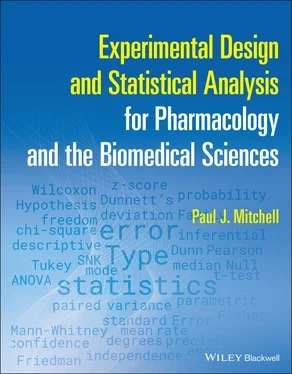1 Cover
2 Title Page Experimental Design and Statistical Analysis for Pharmacology and the Biomedical Sciences Paul J. Mitchell Department of Pharmacy and Pharmacology University of Bath Bath, UK Department of Pharmacology and Therapeutics National University of Ireland (NUI) Galway, Ireland
3 Copyright Page
4 Dedication Page
5 Biography
6 AcknowledgementsHomo Sapiens – Part 1 Statistical Packages Homo Sapiens – Part 2
7 Foreword
8 1 IntroductionExperimental design: the important decision about statistical analysis Statistical analysis: why are statistical tests required? The eye‐ball test! The structure of this book: Descriptive and Inferential Statistics
9 2 So, what are data? Data handling and presentation
10 3 Numbers; counting and measuring, precision, and accuracy Precision and accuracy Errors in measurement Independent observations or duplicate/triplicate/quadruplicate? That is the question!
11 4 Data collection: sampling and populations, different types of data, data distributionsSampling and populations The Central Limit Theorem Types of data Classification of data distributions So why do we need to understand data distribution?
12 5 Descriptive statistics; measures to describe and summarise data sets Parametric Descriptive Statistics and the Normal Distribution Example output from statistical software
13 6 Testing for normality and transforming skewed data sets Transforming skewed data sets to approximate a normal distribution Removing outliers: Grubbs's test QQ plots Example output from statistical software
14 7 The Standard Normal Distribution
15 8 Non‐parametric descriptive statistics Non‐parametric descriptive statistics Example output from statistical software
16 9 Summary of descriptive statistics: so, what values may I use to describe my data?Introduction: the most important question to answer in statistical analysis! What type of data do I have? Taking the first steps to data description and analysis Strategy for descriptive statistics Example data Example output from statistical software Decision Flowchart 1: Descriptive Statistics – Parametric v Non‐Parametric data
17 10 Introduction to inferential statisticsOverview Hypothesis testing Experimental design
18 11 Comparing two sets of data – Independent t ‐testThe Independent t -test Equal group sizes Unequal group sizes Interpretation of the t statistic Example output from statistical software
19 12 Comparing two sets of data – Paired t ‐testThe Paired t-test Interpretation of the t statistic Example output from statistical software
20 13 Comparing two sets of data – independent non‐parametric data The Wilcoxon Rank Sum test and Mann-Whitney U -test The Wilcoxon Rank-Sum test The Mann–Whitney U ‐test Example output from statistical software
21 14 Comparing two sets of data – paired non‐parametric data The Wilcoxon Signed‐Rank test Example output from statistical software
22 15 Parametric one‐way analysis of varianceIntroduction One‐Way Analysis of Variance Source of variance; Total, Between-Group, and Within-Group Relationship between the F ‐ratio and probability So, what do we do next? Multiple pairwise comparisons; post hoc and a priori analysis Data analysis step 1: one‐way ANOVA Data analysis step 2: Post hoc analysis Example output from statistical software
23 16 Repeated measure analysis of varianceIntroduction Repeated measures ANOVA Assessing sphericity Mauchly's test Post hoc tests Example output from statistical software
24 17 Complex Analysis of Variance Models Part A: choice of suitable Analysis of Variance models. Using spreadsheets in experimental design Part B: choice of suitable post hoc pairwise comparisons Mixed ANOVA models Bonferroni and alternative correction procedures Holme correction procedure General comments on complex ANOVA models Example output from statistical software
25 18 Non‐parametric ANOVAOverview Limitations of non-parametric ANOVA models Multiple pairwise comparisons following non‐parametric ANOVA Multiple pairwise comparisons using the Mann–Whitney U‐ test Multiple pairwise comparisons using the Wilcoxon Signed‐Rank test Multiple pairwise comparisons using a variant of Dunn's test Example output from statistical software
26 19 Correlation analysis Bivariate correlation analysis of parametric data Correlation analysis of non‐parametric data Example output from statistical software
27 20 Regression analysis Linear regression Example output from statistical software
28 21 Chi‐square analysis Assumptions of chi‐square analysis Risk, relative risk, and odds ratio Example output from statistical software Decision Flowchart 3: Inferential Statistics – Tests of Association
29 22 Confidence intervals Overview Statistical significance of confidence intervals
30 23 Permutation test of exact inference Rationale
31 24 General Linear Model The General Linear Model and Descriptive Statistics The General Linear Model and Inferential Statistics
32 Appendix A: Data distribution: probability mass function and probability density functions A.1 Binomial distribution (Chapter 4.iii, Figure 4.4): Probability mass function A.2 Exponential distribution (Chapter 4.v1, Figure 4.5): Probability density function A.3 Normal distribution (Chapter 4.vii, Figure 4.7): Probability density function A.4 Chi‐square distribution (Chapter 4.viii, Figure 4.8): Probability density function A.5 Student t‐distribution (Chapter 4.ix, Figure 4.9): Probability density function A.6 F distribution (Chapter 4.x, Figure 4.10): Probability density function
33 Appendix B: Standard normal probabilities
34 Appendix C: Critical values of the t‐distribution
35 Appendix D: Critical values of the Mann–Whitney U‐statistic
36 Appendix E: Critical values of the F distribution
37 Appendix F: Critical values of chi‐square distribution
38 Appendix G: Critical z values for multiple non‐parametric pairwise comparisons
39 Appendix H: Critical values of correlation coefficients Summary Decision Flowchart
40 Index
41 End User License Agreement
1 Chapter 2 Table 2.1 The relative potency of atropine and mepyramine on muscarinic and... Table 2.2 Disease associated with neuropathic pain.
2 Chapter 3 Table 3.1 Estimation of p H.
3 Chapter 4 Table 4.1 Classification of probability distributions.
4 Chapter 5 Table 5.1 Height (m) of 40 female undergraduate students. Table 5.2 Height (m) of 33 male undergraduate students. Table 5.3 Head shake behaviour exhibited by male Wistar rats. Table 5.4 Female height data. Table 5.5Descriptive statistics summary table (Parametric data). Table 5.6 Summary of Mean, Median and Mode values for positively and negati...
5 Chapter 6Table 6.1 Tukey ladder of transformations.Table 6.2 Comparison of measures of central tendency and distribution analy...
6 Chapter 7Table 7.1 Relationship between selected z ‐scores and AUC for the Standard N...
7 Chapter 8Table 8.1 Head shake behaviour exhibited by male Wistar rats.Table 8.2 Time (s) to locate submerged platform in Morris Water maze achiev...Table 8.3 Summary of descriptive statistics (non‐parametric data).Table 8.4 Summary of descriptive statistics.
8 Chapter 9Table 9.1 Assumptions of parametric and non‐parametric data.Table 9.2 Summary of descriptive statistics.Table 9.3 Legitimate use of descriptive statistics.Table 9.4 Summary of depression intensity scored by MADRS.Table 9.5 Effect of a muscarinic receptor agonist to induce contractile res...Table 9.6 Average concentration‐effect data for a muscarinic receptor agoni...Table 9.7 Summary of EC 50data calculations.Table 9.8 Effect of drug treatment on the frequency of rodent Head Shake an...Table 9.9 Non‐parametric descriptive statistics for Head shake and Attempt ...
Читать дальше












